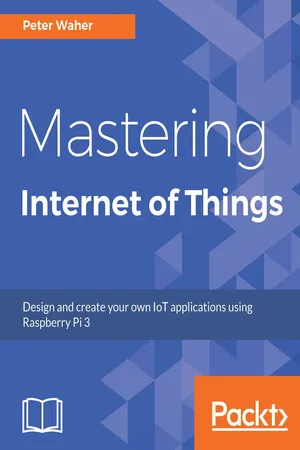
Mastering Internet of Things
Peter Waher
- 410 Seiten
- English
- ePUB (handyfreundlich)
- Über iOS und Android verfügbar
Mastering Internet of Things
Peter Waher
Über dieses Buch
Augment your IoT skills with the help of engaging and enlightening tutorials designed for Raspberry Pi 3About This Book• Design and implement state-of-the-art solutions for the Internet of Things• Build complex projects using motions detectors, controllers, sensors, and Raspberry Pi 3• A hands-on guide that provides interoperable solutions for sensors, actuators, and controllersWho This Book Is ForIf you're a developer or electronic engineer and are curious about the Internet of Things, this is the book for you. With only a rudimentary understanding of electronics and Raspberry Pi 3, and some programming experience using managed code, such as C# or Java, you will be taught to develop state-of-the-art solutions for the Internet of Things.What You Will Learn• Create your own project, run and debug it• Master different communication patterns using the MQTT, HTTP, CoAP, LWM2M and XMPP protocols• Build trust-based as hoc networks for open, secure and interoperable communication• Explore the IoT Service Platform• Manage the entire product life cycle of devices• Understand and set up the security and privacy features required for your system• Master interoperability, and how it is solved in the realms of HTTP, CoAP, LWM2M and XMPPIn DetailThe Internet of Things (IoT) is the fastest growing technology market. Industries are embracing IoT technologies to improve operational expenses, product life, and people's well-being. Mastering Internet of Things starts by presenting IoT fundamentals and the smart city. You will learn the important technologies and protocols that are used for the Internet of Things, their features, corresponding security implications, and practical examples on how to use them. This book focuses on creating applications and services for the Internet of Things. Further, you will learn to create applications and services for the Internet of Things. You will be discover various interesting projects and understand how to publish sensor data, control devices, and react to asynchronous events using the XMPP protocol. The book also introduces chat, to interact with your devices. You will learn how to automate your tasks by using Internet of Things Service Platforms as the base for an application. You will understand the subject of privacy, requirements they should be familiar with, and how to avoid violating any of the important new regulations being introduced.At the end of the book, you will have mastered creating open, interoperable and secure networks of things, protecting the privacy and integrity of your users and their information.Style and approachThis mastering-level guide will immerse you in the advanced functionalities of IoT, along with extending them, and finishes up with security and privacy techniques.
Häufig gestellte Fragen
Information
Using an Internet of Things Service Platform
- An introduction to the IoT Gateway project
- An overview of its architecture
- An introduction to its hardware abstraction layer
- Management through its XMPP architecture
- How to create services
- How to interface things
- Using its databases and persistence layer
- Understanding the hosting environment
- An introduction to its security infrastructure
Understanding the IoT Gateway project
Running the IoT Gateway
| Platform | Executable project |
| Windows console | Waher.IoTGateway.Console |
| Windows service | Waher.IoTGateway.Svc |
| Universal Windows Platform app | Waher.IoTGateway.App |
Running the console version
